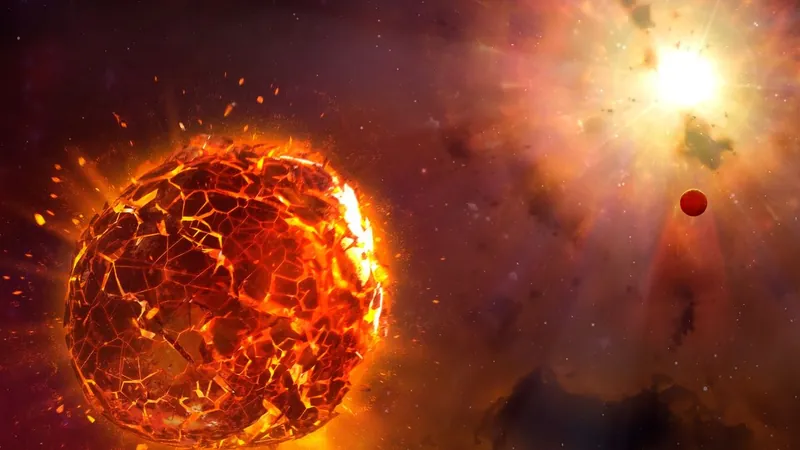
Can a Supernova Spell Doom for Earth? Here’s What You Need to Know!
2024-11-14
Author: Wei
When the massive red supergiant Betelgeuse finally meets its end in a spectacular supernova explosion, the event will be truly cosmic. It could shine brighter than any planet in our sky, rivaling the full moon, and be visible even during daylight hours. You might even be able to read by its light in the middle of the night! However, before you start to worry about an impending apocalypse, rest assured that Betelgeuse is approximately 650 light-years away, making it a safe observational event rather than a deadly threat.
What Would It Take for a Supernova to Endanger Earth?
To determine if a supernova could pose a danger to our planet, let’s dive into the explosive forces unleashed during such an event. Although the shock wave from a supernova is devastating, you would have to be very close for it to threaten your life—and if you were, you'd likely already be receiving lethal doses of radiation long before the fireworks began.
Visible light, with its blinding brilliance, may be impressive but it poses no real threat to the planet. The real danger comes from the plethora of high-energy radiation emitted during the explosion, especially X-rays and gamma rays. These forms of radiation can interact significantly with Earth’s atmosphere. When cosmic rays—the high-speed particles flung through space—are generated in similar cataclysmic events, they can also cause severe damage, especially to the molecules that make up our atmosphere.
The Fallout: What Happens If Our Ozone Layer is Compromised?
If sufficient high-energy radiation were to disrupt the bonds in atmospheric nitrogen and oxygen, we would end up with various nitrogen oxides, including nitrous oxide, known as laughing gas. This chemical transformation poses a severe risk to the ozone layer, which is our planet's shield against harmful ultraviolet (UV) rays from the sun. And it’s not just about sunburns and increased skin cancer; the implications could extend to larger ecological ramifications, as the reduction in ozone levels jeopardizes photosynthetic microorganisms like algae—the foundational building blocks of Earth’s food chains.
In terms of proximity, a supernova would need to occur within about 25 to 30 light-years of Earth to significantly damage our ozone layer and trigger these catastrophic effects. Currently, there are no known supernova candidates within that range—Spica, the nearest one, lies around 250 light-years away, providing us some peace of mind for now.
A Glimpse into the Future: What Lies Ahead?
While we are relatively safe from supernova-related destruction today, the future carries uncertainties. Our solar system is making its journey through the Orion spiral arm of the Milky Way, an area known for prolific star formation. With each new star born, there's a corresponding risk of their demise, which could pose threats as we traverse this area over the next 10 million years.
Some estimates suggest that we could likely face a deadly supernova on a scale of a few times in every billion years. In fact, it's speculated that a supernova might have played a role in a mass extinction event roughly 360 million years ago, resulting in the loss of 75% of all species on the planet!
The Intricacies of Supernova Types: More Threats Than Expected?
The mechanics of supernovae are complex. Interestingly, there’s a specific type of supernova where the precursor star is hidden beneath layers of dust. This dust clouds the initial shock wave, leading to a delayed explosion of X-rays and subsequently powerful cosmic rays. Such events could severely alter planetary atmospheres over hundreds of years.
Furthermore, Type Ia supernovas are another complication, triggered by white dwarfs accumulating material from companion stars. The challenge with these is twofold: they are often dim and short-lived, making them harder to detect, and they can explode rather unpredictably.
The nearest candidate for a Type Ia supernova, IK Pegasi, resides about 150 light-years away, likely out of reach of causing catastrophic damage—but it’s not the only concern. Gamma-ray bursts, resulting from neutron star mergers, are incredibly powerful and release focused beams of energy that can penetrate over 10,000 light-years. Their unpredictable nature makes them particularly worrying.
As we ponder the cosmos, it’s essential to remember that while the likelihood of a supernova endangering Earth appears low, the risks are not negligible. So, keep your eyes on the stars—and sleep tight, knowing that, for now, we’re safe from supernova doom!




 Brasil (PT)
Brasil (PT)
 Canada (EN)
Canada (EN)
 Chile (ES)
Chile (ES)
 España (ES)
España (ES)
 France (FR)
France (FR)
 Hong Kong (EN)
Hong Kong (EN)
 Italia (IT)
Italia (IT)
 日本 (JA)
日本 (JA)
 Magyarország (HU)
Magyarország (HU)
 Norge (NO)
Norge (NO)
 Polska (PL)
Polska (PL)
 Schweiz (DE)
Schweiz (DE)
 Singapore (EN)
Singapore (EN)
 Sverige (SV)
Sverige (SV)
 Suomi (FI)
Suomi (FI)
 Türkiye (TR)
Türkiye (TR)